Attached files
| file | filename |
|---|---|
| 8-K - 8-K - Zynerba Pharmaceuticals, Inc. | a18-2182_18k.htm |
| EX-99.1 - EX-99.1 - Zynerba Pharmaceuticals, Inc. | a18-2182_1ex99d1.htm |
Strategy Focused on Rare and Near-Rare Neuropsychiatric Disorders January 4, 2018 Dedicated to the development and commercialization of innovative transdermal pharmaceutically-produced cannabinoid treatments for rare and near-rare neuropsychiatric conditions in patients with high unmet medical needs
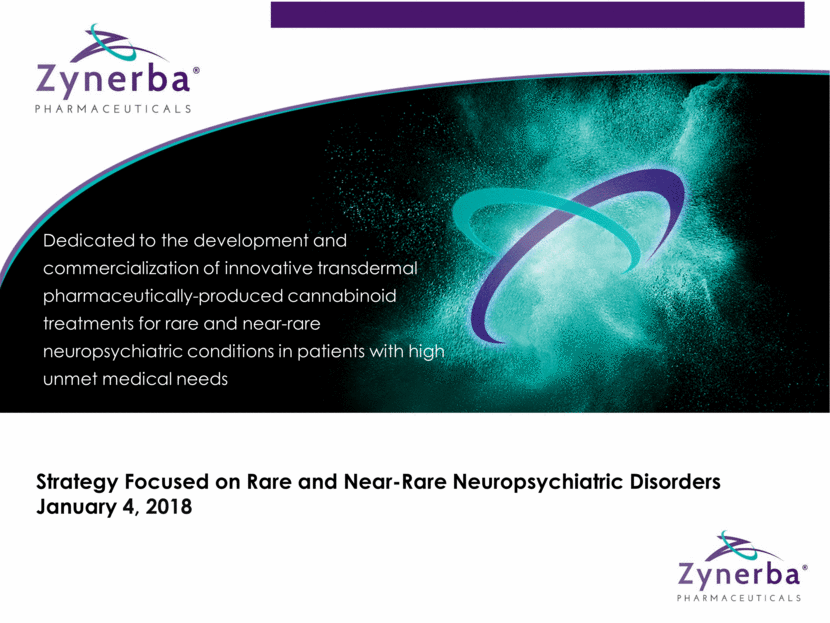
Disclaimer The statements in this presentation may include forward-looking statements within the meaning of Section 27A of the Securities Act of 1933, as amended, and Section 21E of the Securities Exchange Act of 1934, as amended. These statements, among other things relate to the future operations, opportunities or financial performance of Zynerba Pharmaceuticals, Inc. We may, in some cases, use terms such as “predicts,” “believes,” “potential,” “proposed,” “continue,” “estimates,” “anticipates,” “expects,” “plans,” “intends,” “may,” “could,” “might,” “will,” “should” or other words that convey uncertainty of future events or outcomes to identify these forward-looking statements. Such statements are subject to numerous important factors, risks and uncertainties that may cause actual events or results to differ materially from the Company’s current expectations. These and other risks are described in our filings with the Securities and Exchange Commission, available at www.sec.gov. Any forward-looking statements that the Company makes in this presentation speak only as of the date of this PRESENTATION. The Company assumes no obligation to update forward-looking statements whether as a result of new information, future events or otherwise, after the date of this presentation. © 2018 Zynerba Pharmaceuticals, Inc. All rights reserved. Zynerba is a trademark of Zynerba Pharmaceuticals, Inc. All other trademarks and registered trademarks are property of their respective owners. 2
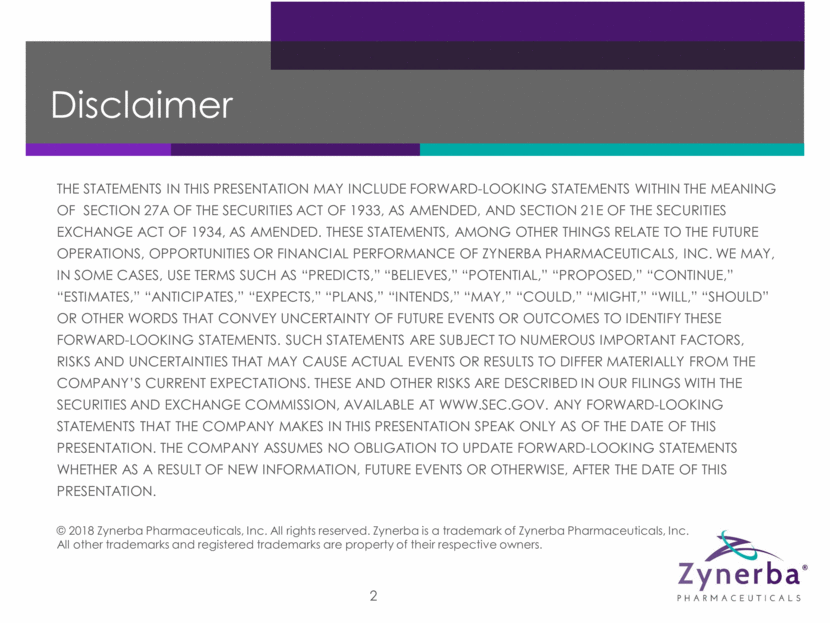
Rare/Near-Rare Neuropsychiatric Strategy Dedicated to the development and commercialization of innovative transdermal pharmaceutically-produced cannabinoid treatments for rare and near-rare neuropsychiatric conditions in patients with high unmet medical needs 3

Concentrating on rare (orphan; <200K patients) and near-rare (<1 million patients) neuropsychiatric diseases: ZYN002 (CBD gel) Fragile X Syndrome: 1Q18 meeting with FDA; plan to initiate pivotal program mid-year 2018 Developmental and epileptic encephalopathies (DEE): Plan to initiate pediatric/adolescent trial in 1H18 Adult refractory focal epilepsy: Plan to initiate Phase 2B trial in 2H18 Assessing other potential neuropsychiatric indications ZYN001 (THC prodrug patch) Expect to complete ongoing Phase 1 trials in 1H18 Tourette Syndrome: Plan to initiate Phase 2 trial in late 2H18 Assessing other potential neuropsychiatric indications Discontinuing investment in capital-intensive pain programs ZYN002 in osteoarthritis ZYN001 in fibromyalgia and PNP Rare/Near-Rare Neuropsychiatric Strategy 4
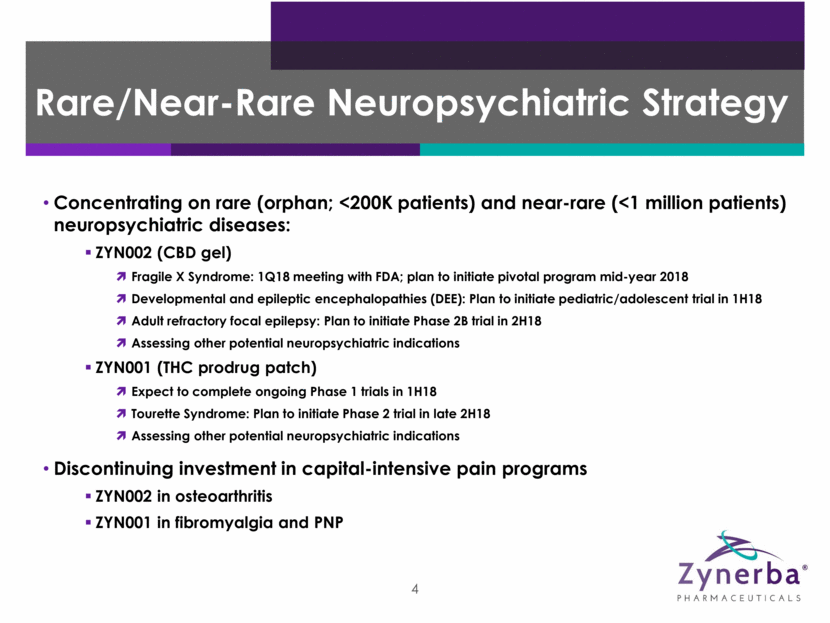
High unmet medical needs and significant market opportunities Fragile X Syndrome: ~71K US patients; no approved products DEE: Category of rare and ultra rare, severe brain disorders manifesting with seizures, including Lennox-Gastaut and Dravet syndromes Refractory focal epilepsy: AEDs fail in ~500K US patients Tourette Syndrome: ~200K US patients with most severe form of TS Opportunities for efficient development and commercialization strategy Orphan drug designation provides opportunity for rapid development/approval FDA Breakthrough Therapy Designation, Fast Track Status, Accelerated Approval or Priority Review Designation, if granted, can accelerate approval of drugs that meet respective criteria Targeted physician audience = modest commercial investment Potential for consistent pricing across indications Expected reduction in long term capital requirements by discontinuing pain programs Rare/Near-Rare Neuropsychiatric Strategy 5
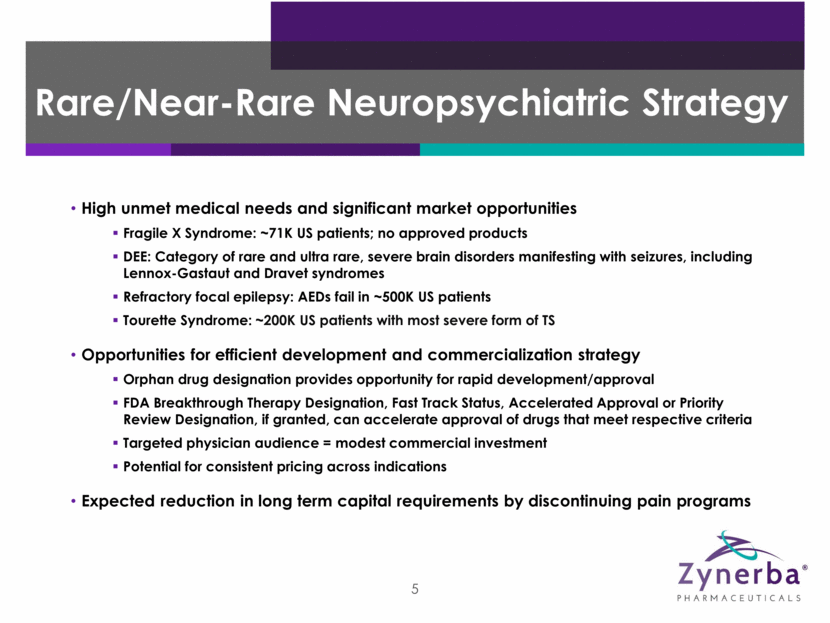
Inherited autism spectrum disorder with symptoms linked to deficiencies in the endocannabinoid system ECs form system of neurotransmitters regulating emotional responses, behavioral reactivity to context, social interaction FMR1 mutation in FXS causes dysregulation of the EC system resulting in significant social, behavioral, and cognitive deficits Modulation of EC system with CBD may have therapeutic potential in ameliorating some of those symptoms Strong scientific rationale in FXS validated by Phase 2 FAB-C clinical data 6 U.S. Orphan Drug Designation for use of CBD as a treatment of Fragile X syndrome has been granted by the FDA Fragile X Syndrome (FXS) The Endocannabinoid (EC) System is a Critical Pathway ZYN002
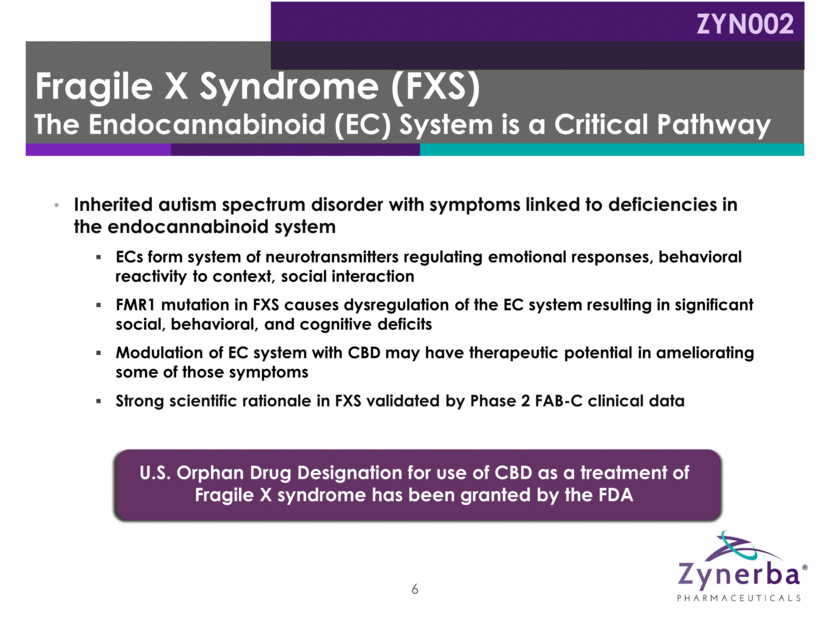
Primary endpoints achieved in FAB-C 12 week Phase 2 open label study 46% improvement (p<0.0001) in the ADAMS total score at week 12 vs baseline Results of secondary endpoints reinforce the results demonstrated in ADAMS Meeting scheduled with FDA in 1Q18 to discuss development strategy including clinical pivotal program Expect to initiate Phase 2/3 pivotal program in mid-year 2018 Evaluating opportunities for FDA fast-track status, breakthrough therapy designation, and/or accelerated approval Assessing opportunity to present / publish full data set as soon as possible in 2018 7 ZYN002 in Fragile X Syndrome FAB-C Primary Endpoint: ADAMS total score Improvement vs. baseline (N=20) Changes in Anxiety, Depression and Mood 46% (p<0.0001) FAB-C Secondary Endpoint: ABC-FXS subscale Improvement vs. baseline (N=20) Stereotypy: "Repetitive Movements" 59% (p=0.0006) Social Avoidance: "Seeks Isolation" 55% (p=0.0005) Socially Unresponsive/Lethargic: "Does Not Pay Attention" 53% (p=0.0034) Inappropriate Speech: "Repeats Words or Phrases" 43% (p=0.0018) Irritability: "Has Temper Tantrums" 42% (p=0.0096) Hyperactivity: "Disrupts Group Activities" 33% (p=0.0194) ZYN002
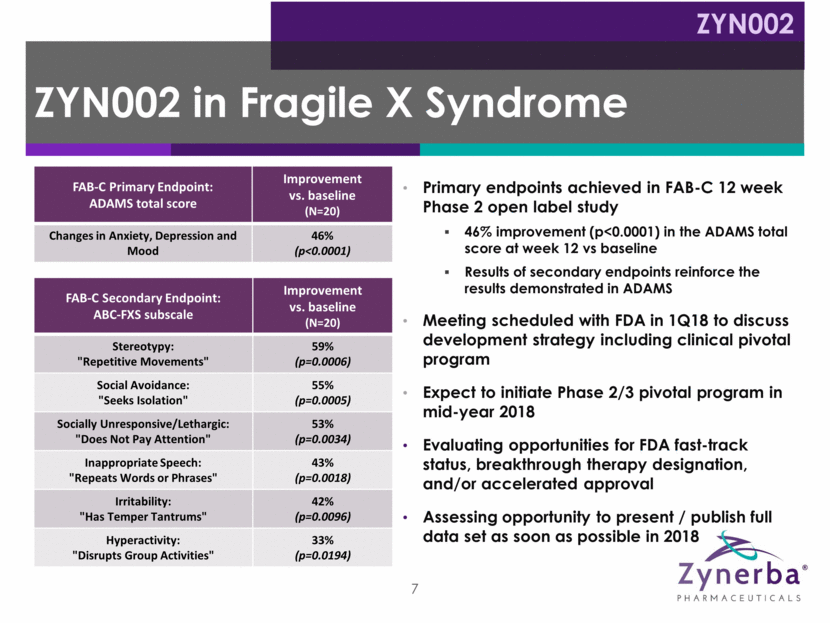
Category of rare and ultra-rare severe brain disorders that manifest with seizures or EEG abnormalities that can directly worsen cognition or behavior Often progressive; highly resistant to treatment Treatment of seizures or EEG abnormalities expected to improve the cognitive or behavioral deficits and reduce the seizures Third party clinical data show impact of CBD on seizures and behavioral issues Developmental and Epileptic Encephalopathies Doose Syndrome Dravet Syndrome Early Myoclonic Encephalopathy Epilepsy of Infancy With Migrating Focal Seizures Epilepsy with Generalized Tonic-Clonic Seizures alone (EGTCS) Juvenile Myoclonic Epilepsy (JME) Landau-Kleffner Syndrome Lennox-Gastaut Syndrome Ohtahara Syndrome (Early Infantile Epileptic Encephalopathy) West Syndrome / Infantile Spasms DEE category includes: 8 ZYN002

Expect to initiate open label study in 1H18 48 pediatric and adolescent patients (3 to <18 years old) 24 week, multi-dose trial ranging from 195 mg/day to 780 mg/day Primary endpoints: reduction in seizures at 12 weeks and 24 weeks Results will determine next steps Twelve month extension trial to follow 9 Proposed Phase 2 Study of ZYN002 in DEE Trial Design* ZYN002 *Note: Subject to change due to further regulatory, clinical and other considerations.
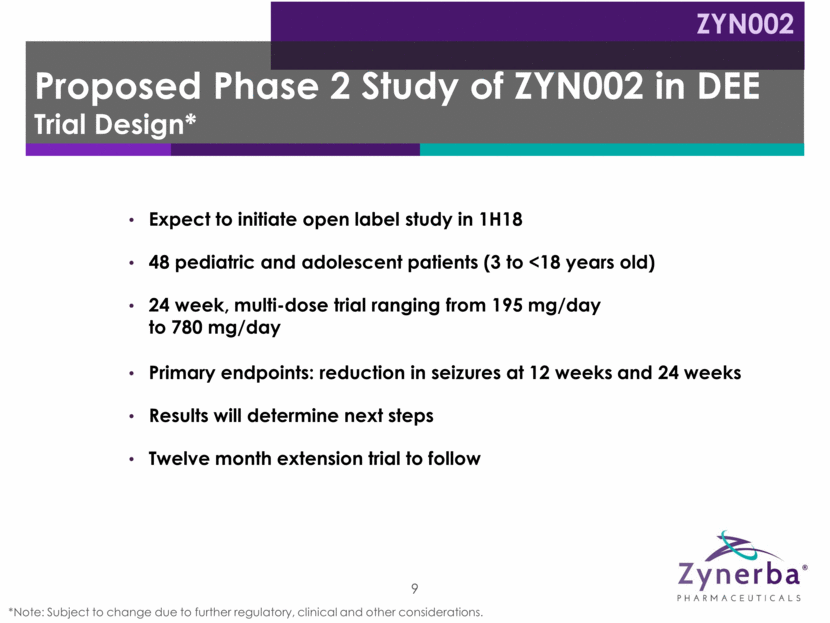
Refractory Focal Epilepsy STAR 1 and STAR 2 Findings Learnings provide input to a revised Phase 2b clinical trial design Company believes that 12 week STAR 1 Phase 2 study missed primary endpoint due to bimodal distribution of placebo patient responses Response to ZYN002 correlated to baseline seizure severity Patients with severe epilepsy (>15 seizures/month) receiving ZYN002 had greater percent seizure reduction than patients with less severe epilepsy (<15 seizures/month) ZYN002 was very well tolerated in STAR 1 and STAR 2 STAR 2 data suggest clinically meaningful response with longer term use of ZYN002 10 ZYN002

11 -18.4 N=62 -14.0 N=61 -13.4 N=59 -32.68 N=55 -30.04 N=55 -26.53 N=24 -65.23 N=21 -48.45 N=18 195 mg – 390 mg Placebo – 390 mg 390 mg – 390 mg Median Percent Change in Seizure Rates Dose Regimen in STAR 1 and STAR 2 STAR 2 results based on data collected through mid-August 2017 and in patients who reported seizure frequency data during the respective time period. Not all patients had reached 3 and 6 months in STAR 2 as of mid-August 2017 STAR 1 3 mos STAR 1 3 mos STAR 1 – 3 mos STAR 2 – 3 mos STAR 2 3 mos STAR 1 – 3 mos STAR 2 – 6 mos STAR 2 – 6 mos STAR 1 – 3 mos STAR 2 – 6 mos STAR 1 – 3 mos STAR 2 – 3 mos Consistent Results at Various Timeframes Three Months on ZYN002 ZYN002

12 -18.4 N=62 -14.0 N=61 -13.4 N=59 -32.7 N=55 -30.0 N=55 -26.5 N=24 -65.23 N=21 -48.45 N=18 195 mg – 390 mg Placebo – 390 mg 390 mg – 390 mg Median Percent Change in Seizure Rates Dose Regimen in STAR 1 and STAR 2 STAR 2 results based on data collected through mid-August 2017 and in patients who reported seizure frequency data during the respective time period. Not all patients had reached 3 and 6 months in STAR 2 as of mid-August 2017 STAR 1 3 mos STAR 1 3 mos STAR 1 – 3 mos STAR 2 – 3 mos STAR 2 3 mos STAR 1 – 3 mos STAR 2 – 6 mos STAR 2 – 6 mos STAR 1 – 3 mos STAR 2 – 6 mos STAR 1 – 3 mos STAR 2 – 3 mos Consistent Results at Various Timeframes Six Months on ZYN002 ZYN002
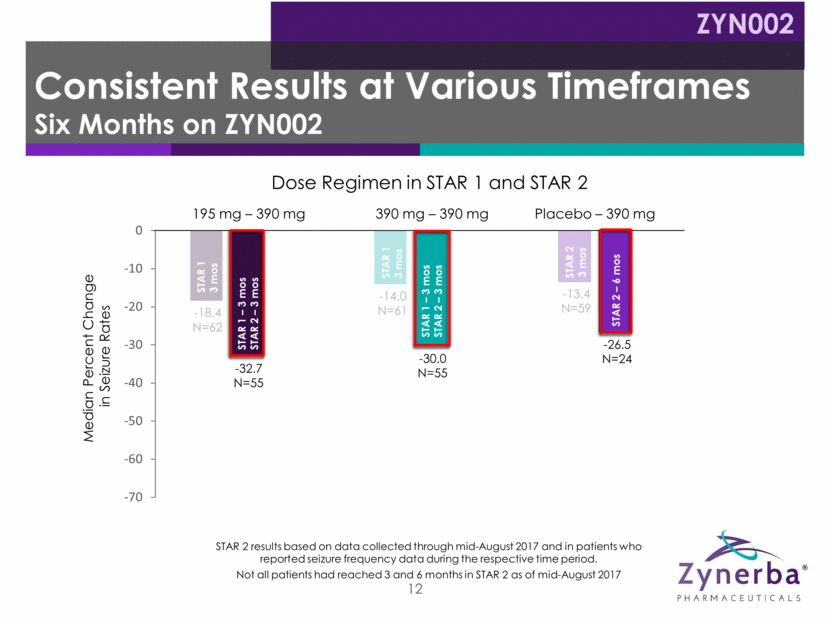
13 -18.4 N=62 -14.0 N=61 -13.4 N=59 -32.7 N=55 -30.0 N=55 -26.5 N=24 -65.2 N=21 -48.5 N=18 195 mg – 390 mg Placebo – 390 mg 390 mg – 390 mg Median Percent Change in Seizure Rates Dose Regimen in STAR 1 and STAR 2 STAR 2 results based on data collected through mid-August 2017 and in patients who reported seizure frequency data during the respective time period. Not all patients had reached 3 and 6 months in STAR 2 as of mid-August 2017 STAR 1 3 mos STAR 1 3 mos STAR 1 – 3 mos STAR 2 – 3 mos STAR 2 3 mos STAR 1 – 3 mos STAR 2 – 6 mos STAR 2 – 6 mos STAR 1 – 3 mos STAR 2 – 6 mos STAR 1 – 3 mos STAR 2 – 3 mos Consistent Results at Various Timeframes Nine Months on ZYN002 ZYN002

~300 patient double-blind placebo controlled study To be conducted in US, Australia and New Zealand Primary endpoint: reduction from baseline in focal seizures 1:1:1 ratio (195 mg: 780 mg: placebo) 14 Learnings from STAR 1 and STAR 2 experience include: Stratified randomization by baseline seizure rate and gender Increase in patient count Increase trial duration Increase in baseline seizure frequency Median seizure target: >15/month vs 10.6 in STAR 1 Design* Modifications Expected to initiate in 2H18 Open label extension to follow Proposed Phase 2b Study Adult Refractory Focal Epilepsy ZYN002 *Note: Subject to change due to further regulatory, clinical and other considerations.
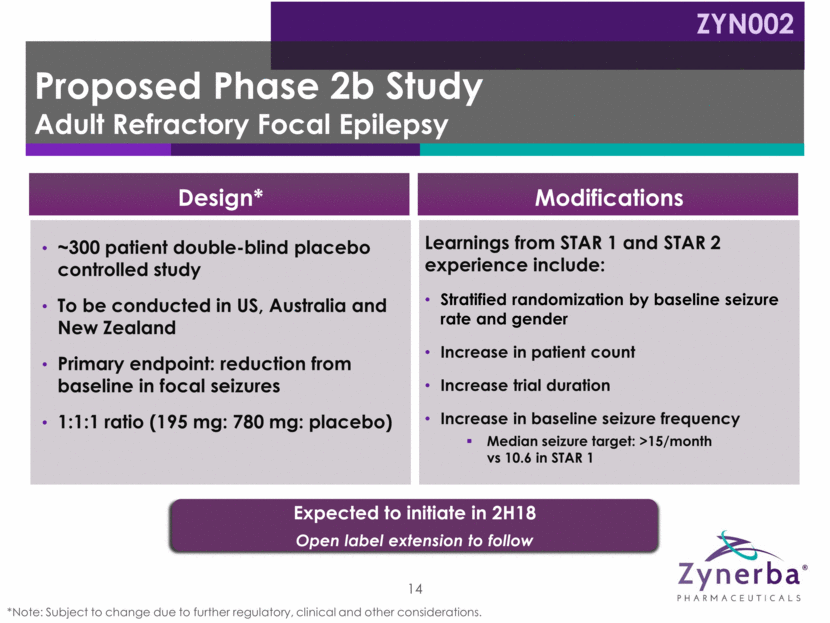
15 Potential for THC in Tourette Syndrome (TS) Neurodevelopmental disorder characterized by motor / vocal tics Evident in early childhood ~200K US pts have most severe form according to the National Institute of Neurological Disorders and Stroke Up to 1:100 exhibit milder and less complex symptoms Overview Rationale Phase 2 study expected to initiate in late 2H18 Central cannabinoid receptor system believed to play role in Tourette Syndrome pathology Two third party double blind, placebo controlled studies show activity of THC in TS Assessments included self- and examiner-rated scales validated in TS (TSSL, TS-CGI, YGTSS, others) Statistical significance achieved vs placebo in tic severity and obsessive compulsive behavior ZYN001

Responsibilities will include clinical strategy and execution, clinical research, medical affairs, regulatory affairs, and drug safety and surveillance 25 years of experience in rare and neuropsychiatric disorders Vice President, Therapeutic Area Head, Neuroscience for Aevi Genomic Medicine Led neuroscience product strategy and development Chief Medical Officer for Lumos Pharma Developed an accelerated development strategy for an ultra-orphan population 10 years at Shire Pharmaceuticals, culminating as Vice President of R&D and Product General Manager of CNS Early Pipeline Director of Pediatric Neurology for DeVos Children’s Hospital Board certified in Neurology and Psychiatry, and Pediatrics 16 Liza Squires, MD Newly Created Role of Chief Medical Officer

17 Expected 2018 Milestones 1Q 2Q 3Q 4Q ZYN002 Fragile X Syndrome FDA meeting 1Q18 DEE Initiate Phase 2 open label study in 1H18 Adult refractory focal epilepsy Initiate new Phase 2B study in 2H18 Present/publish additional data from STAR 2 extension study in 2018 ZYN001 Tourette Syndrome Complete Phase 1 formulation study in 1H18 Initiate Phase 2 study in Tourette Syndrome by year end 2018 Other indications Assessment of other rare and near-rare neuropsychiatric disorders in 2018 Other indications Assessment of other rare and near-rare neuropsychiatric disorders in 2018 Initiate pivotal trial: Mid-Year 2018 Present/publish additional data from Phase 2 FAB-C study in 2018

Experienced team with proven development and commercialization track record in transdermal delivery, orphan diseases, neurology, and psychiatry Global ownership of two proprietary product candidates with potential applicability to numerous neuropsychiatric disorders Capital efficient development and commercialization strategy anticipated Multiple expected milestones in 2018 Well capitalized with cash runway well into 2019 Zynerba Is Well Positioned to Execute on Neuropsychiatric Focused Strategy 18
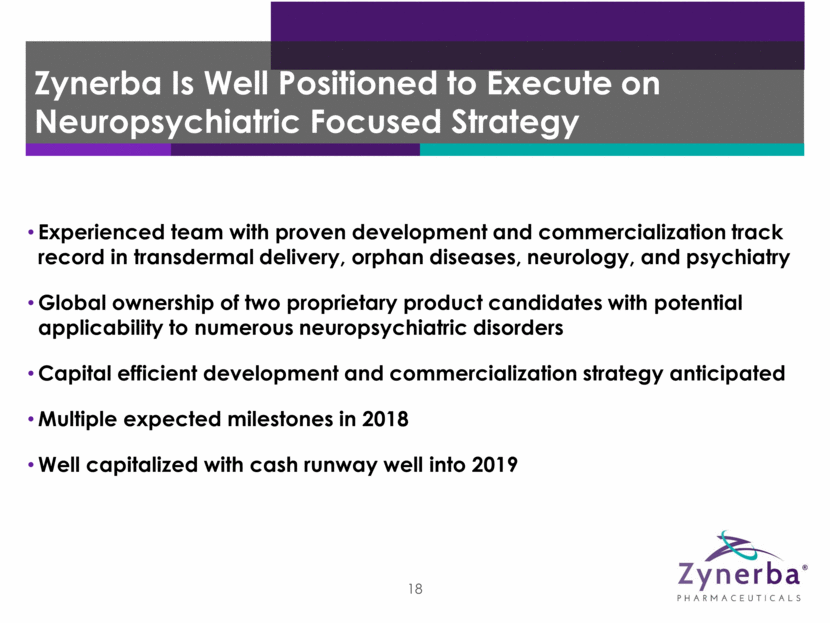
Question & Answer Session 19

